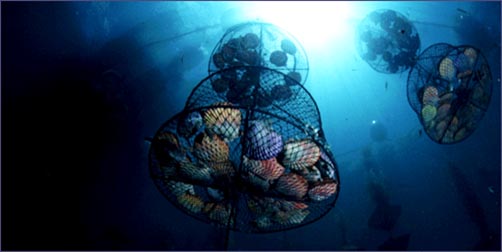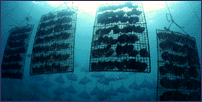
|
No.17 Nobel Scallop Breeding in Uwajima. |

|
No.17 Nobel Scallop Breeding in Uwajima. |

|
|
|
Nobel Scallop breeding. The Nobel Scallop basket hanging in the water was being slowly lapped by the waves and enjoying the sun's rays. It looked like a fruitbasket to me. |
|
|
It happened in southwest Shikoku when I was diving in the sea in the
southern part of Ehime Prefecture to report on the marine life in
Uwakai. When I happened to look up, there was a breeding raft for Nobel
Scallops. I am normally flat on the seabed looking for marine life but
the Nobel Scallop breeding basket looking like a mobile with its joyful
movements, enticed me to go back up near the surface.
The hiougigai is a beautiful shellfish. Not only is it beautiful, it is also delicious. On the breeding raft in the quiet inlet, many colored Nobel Scallops, yellow, orange, and purple, are ripening deliciously by leaching out nutrients from the seawater. I still remember that I was surrounded by Nobel Scallops and enjoyed a mysterious time. It was as if I had strayed into an orchard in the sea. I asked the owner of the breeding raft who was near the beach, he told me he used to specialize in pearls but since the pearl market fluctuates greatly from year to year, he began growing edible Nobel Scallops for a more stable livelihood. According to documents, the Uwakai is the center for the gathering of Akoyagai-shell to grow the irritant to produce pearls and the breeding of cultured pearl oysters. The geographical features of the Rias coast create a quiet inlet, which is the perfect place for floating these rafts. After I finished my report on Uwakai, I happened to be watching TV when a news bulletin flashed across: ''An unknown disease strikes cultured pearls in Uwaki, and delivers a crushing blow.'' As I watched nervously because I had just recently visited to collect data, the report mentioned the relationship between the pearl culturing industry and the tiger puff fish breeders had deteriorated. The tiger puffer breeder gave formalin baths to prevent parasites from attacking the tiger puffers and the formalin drained into the sea. The pearl industry believed this to be the cause of the destruction. This is how the conflict started. In the midst of my worry about the course of the conflict, it was announced that the cause of the disease was a virus. The conflict between the tiger puffer breeders and the pearl industry settled down. The pearl industry had been increasing the number of oysters on the raft to in crease productivity. Because of this, each oyster became weak and susceptible to disease. I think the reason why people are charmed by pearls, the jewel of the sea, is because they feel in its smooth beauty, the blue movement of the energy of the sea. We sense the abundant sea with our tongue in the silk like feel of a row of tiger puff fish but I wonder if we will continue to be cheated by not also sensing the smell of a powerful chemical called formalin.  I feel very strongly that a fisherman who does not listen to the voice of the sea and thinks only of profits with his abacus in hand, is not fit to be called a man of the sea. I feel very strongly that a fisherman who does not listen to the voice of the sea and thinks only of profits with his abacus in hand, is not fit to be called a man of the sea.
|
|
Culturing pearls. The Uwakai Sea is Japan's largest pearl farm. Pearl culture raftsmostly cover the huge bay. |
|
|